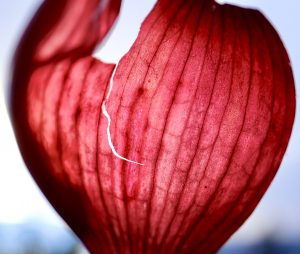
Carrying two red onions just pulled from the garden soil, I squatted at the compost to wash them. Mired in grumpy thoughts, I hardly noticed peeling back the outer layers, feeling wronged in a situation, reviewing the ways how and basically stating my case, though to whom I couldn’t say. Not the onions.
As I pulled the red outer layer of one onion from its bulb, sunlight caught it and turned onion skin into brilliant ruby light. My mind stopped, I gasped at this exquisite color, felt awe and wonder. Peevish thoughts were gone; they seemed silly and unimportant in this bright glory, this heart-stopping beauty before me. The world felt changed. My mind was changed.
Certainly I had been moved by beauty prior to this red onion ruby brilliance: light shimmering on the lake, the call of a loon, the scent of jasmine in the evening, the perfection of a newborn child’s fingernail, the shimmer of birch leaves in a breeze. But the red onion event caught me by surprise and altered my mind and heart so entirely in the moment that it initiated a curiosity about beauty, about its potential, its mystery.
Not long after this experience, I read about Jacob Boehme, a Lutheran shoemaker with no formal education. One day, as he focussed his attention on sunlight reflected in a pewter bowl, he was transported in a vision that revealed the spiritual structure of the cosmos. Several years later, he began to write about what he experienced, creating through the remainder of his life, thirty-two books about the cosmic relationship of humans, human purpose and the Divine. His books are still widely read and discussed. Staring at sunlight in a bowl had a far greater impact on Boehme than the red onion skin did for me, but in both cases, the power of beauty had significant effect.
Viktor Frankl, a psychiatrist and survivor of Auschwitz, told how he and other prisoners sat on their hut floor, exhausted from the day’s work, when another prisoner rushed in and bid them come outside. There the men stood in awe, deeply moved by a radiant sunset. For a time, their circumstances were transcended. Beauty doesn’t make grief, ugliness, pain and devastation go away. It makes them bearable and offers hope, a portal to more.

In her book Braiding Sweetgrass, Robin Wall Kimmerer tells of the beauty she encountered as a young girl when intense purple asters and brilliant goldenrod grew together each year. She asked: Why do they stand beside each other when they could grow alone? [I]s it only happenstance that the magnificence of purple and gold end up side by side? What is the source of this pattern? Why is the world so beautiful?
These questions were later offered as part of her response to her university entrance interview, when asked, “Why do you want to become a botanist?” The questions were dismissed. “Not science,” said the professor. Many years later she had her PhD in botany but along with it a sense of having lost something of her indigenous understanding, of her wonder at the beauty of the world.
She was invited to a Navajo woman’s presentation about plants and was jolted by what she heard. She spoke of beauty, Kimmerer said. It took her back to her entrance interview when her enthusiasm for becoming a botanist was so soundly rejected. “Beauty is not a valid scientific study,” she was told. Hearing the Navajo woman speak, Kimmerer understood that she should have explained to the professor that her questions were bigger than what science could teach.
It was the reciprocal learning from both her Indigenous background and scientific study that revealed an understanding of the asters and goldenrod. The reciprocity of blazing gold and intense purple made something of intense beauty. She realized: That pairing of purple and gold is lived reciprocity; its wisdom is that the beauty of one is illuminated by the other. Science and art, matter and spirit, indigenous knowledge and Western science – can they be goldenrod and aster for each other? When I am in their presence, their beauty asks me for reciprocity, to be the complementary color, to make something beautiful in response.
Her entrance interview reminded me of a first year English class when we were reading the John Keats’ poem Ode on a Grecian Urn. As I was pondering words from the closing – Beauty is truth, truth beauty – the professor belittled them. He stated that Keats “had obviously run out of inspiration. Anyone could have written that. Besides, who can say what beauty is? It’s a matter of opinion, of taste.” My ideas were still forming, my understandings were felt more than articulated.
I did know, however, that beauty was not a matter of opinion nor of fluctuating fashion, but a matter of inner experience. I knew that Keats had not lost his connection with this inner knowing. I feared the professor had.
Keats’ statement that equates beauty and truth has never settled into a defined meaning. It continues to stimulate my exploration the way any good poem does, without necessarily landing on a definitive explanation. Many years after that English class, I was pleased to find the words of the Arab mystic, scholar and poet, Ibn ‘Arabi, “Beauty is the welcoming openness of the Truth toward us.”
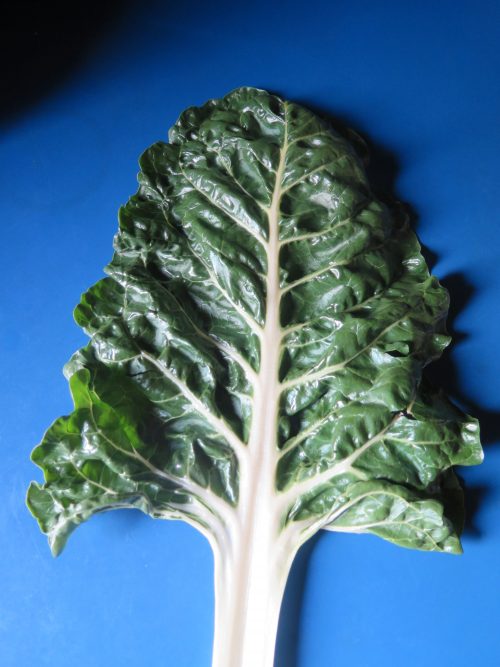
Beauty does act like an opening to something more real, like a door to expanded understanding, like the experience of an expanded heart. Like truth. The mind ceases its treadmill chatter, time stops, everything is held in the present moment of wonder and awe. Beauty changes the world because it changes perception, alters the mind.
“Let the beauty you love be what you do. There are a thousand ways to kneel and kiss the ground,” said Rumi. An individual experience of beauty becomes the opening to meaning, blessing, purpose. That which is felt as beautiful can be a path that blesses existence and serves the world. This echoes Kimmerer’s feeling of the reciprocity of beauty. When in its presence, she felt compelled to make something beautiful in return.
Conscious action in the name of beauty is demonstrated in the work of Trebbe Johnson who founded Global Earth Exchange, an organization that supports people and communities in going to wounded places of our earth and expressing simple acts of beauty there. This global action grew from her own work which she described in her book, Radical Joy for Hard Times.
As she searched for a way to deal with the sorrow of places that had been destroyed, polluted, damaged, desecrated, she found that creating beauty there brought a sense of healing and contribution. It also helped her see the beauty that was still present in the destruction.
I experienced the potency of such action after large pieces of our local forest were brutally cleared of all growing things, the land left with piles of log and debris waste, bared to dusty soil. It felt heart-breaking.
For several months afterward, I carried in my car a small pack with a few harmonic tuning forks in it. Whenever I drove past one of these areas, I stopped, carried the forks with me onto the land and played harmonious sounds for it, asking for healing for its wounds, expressing sorrow for what had been done, apologizing for this human action. Reading about Trebbe Johnson’s work, I understood from my own experience how powerful such actions could be and how meaningful to see them grow to a global community of action.
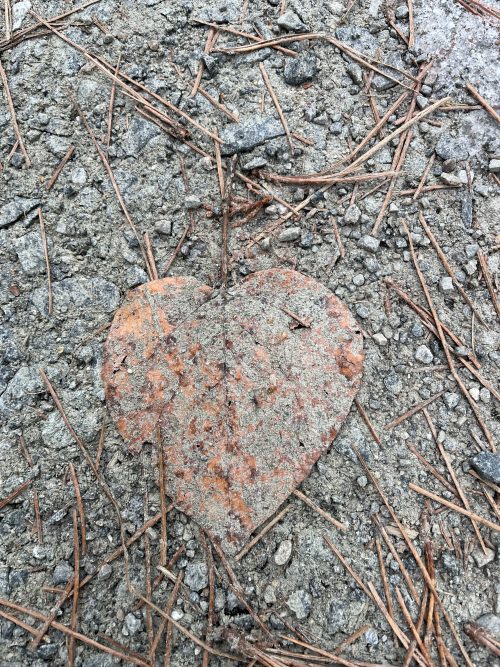
The red onion experience had prodded me to explore beauty. Having the blessing of a garden gave ample opportunity to do this daily. I began to notice abundant places where beauty brought me to a halt in wonder. It was while writing a book about garden learnings (The Impermanence of Broccoli and Other Lessons from the Garden) thatI was introduced to another understanding of beauty.
I learned that something actually happens in the brain in an encounter with beauty. Research in the fields of neurobiology, psychotherapy and psychiatry shows that humans perceive the world in vastly different ways, depending on which hemisphere of the brain is dominant. A simplified summary of how brain hemispheres and beauty are related goes like this:
The worldview of technologically developed cultures tends to be a left brain dominant one, seeing things as separate from each other and seeing the natural world as unconnected to humans, a resource to be used. In addition, humans operate more in left brain perception when they feel threatened and unsafe, and respond unconsciously with a flee, fight or disassociate behavior.
Beauty, it turns out, activates the brain’s right hemisphere and brings a balancing influence to the left brain sense of isolation, separateness, despair, fear or overwhelm. Beauty activates a sense of the present moment and this also balances the left brain tendency to respond with actions of retreat and shutting down when feeling threatened and unsafe. When both hemispheres function in balance, there is greater awareness of wholeness, connectivity and the now.
Beauty and presence can be corrective influences, antidotes to closing down awareness when anxiety and grief emerge in response to what has happened to our world.
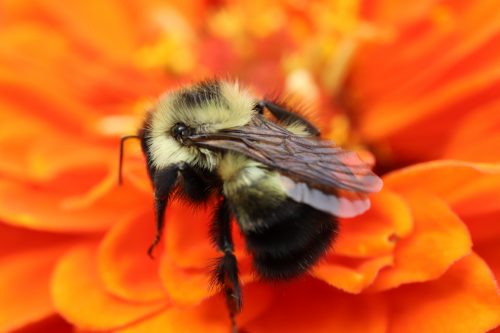
For the sake of this world in these troubled times, we can’t afford these conditioned responses of shutting down or cutting ourselves off. The need is to stay receptive and present, to be awake, able to recognize appropriate responses for the situation that may emerge. Beauty here can function like the reciprocal pairs mentioned by Kimmerer, in this case pairing both sides of the brain, for each to illumine the other.
When she asked herself why the world was so beautiful, Robin Wall Kimmerer realized that it didn’t have to be, that it could have been created in an ugly way. Her insight into the reciprocity of beauty evoked understanding that an encounter with beauty is a call to offer beauty in return.
The mythological tales of returning to the perfection of Shambala or the Garden of Eden are the possibility when we take up this insight, each of us offering our part in restoring the earth to a beautiful garden. I recall the words of Buddhist teacher Thich Nhat Hahn: When we appreciate and honor the beauty of life, we will do everything in our power to protect all life.”
This may be one aspect as to why beauty is elevated in spiritual traditions worldwide, that it can offer a path to wholeness. In its deliberate exploration, I have had glimpses of its larger potential but suspect it holds much more than I comprehend. That beauty opens the heart, that it brings the perceiver to the present moment, that it suspends the chatter of the mind all suggest its potency in encouraging these traditional spiritual practices of being present, stilling the mind, opening the heart.
Kabir Helminski, a modern Sufi lineage holder and teacher, writes that presence is the state of heartful awareness that allows us to open to ever more subtle experiences of meaning, inspiration and beauty. We are back to the reciprocity of asters and goldenrod, in this case presence and beauty, each actively lighting the other.
I feel like beauty is a dimension of spiritual learning that I have overlooked. Qualities such as love, compassion, presence, acceptance, forbearance, forgiveness, attention – these ideals are often challenging, especially in difficult moments. Maybe they’re supposed to be, as difficult moments reveal the extent that the ideals have been integrated.
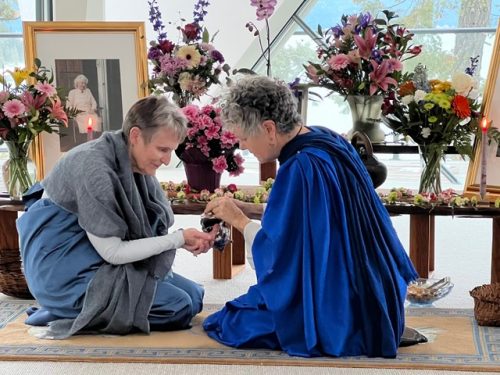
But beauty as an ideal? How great is that? It recalls the words of Dr. Zach Bush: If we make a conscious effort to elevate beauty in our work and our relationships, we can focus on doing our highest work and witnessing, with pleasure, the fabric of reality.
It’s a gift, certainly, full of wonder. As I notice and appreciate it, beauty appears unbidden more and more. The garden flowers are fabulous but so are the bubble patterns in a boiling pot of pasta, the design harmony of a sliced cucumber, the swirl of water when mopping a floor. Can responding to this beauty really be a spiritual practice? An ideal that illuminates and strengthens other ideals? I want to answer Yes. Wow. Thanks.
The Navajo prayer, In Beauty I Walk, ends with the statement: It is finished in beauty. I don’t know what this means but wonder: could it be that all our offerings in life are completed in beauty?
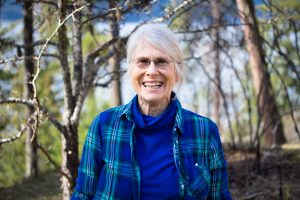
Alanda Greene lives in the Kootenay Bay, British Columbia, Canada. Having a deep connection with nature, she and her husband built their house of stone and timber overlooking a terraced garden, and integrated their life into this rural community. Alanda’s primary focus is the conscious integration of spirit with all aspects of life.
